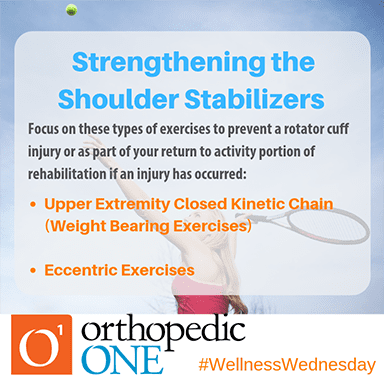Dynamic Rehab of the Shoulder Stabilizers
The musculature of the shoulder is the primary source of stability in and around the shoulder, and is key in keeping the humeral head in the socket. The four muscles that are most active as stabilizers of the shoulder joint are commonly grouped together and collectively known as the rotator cuff. These muscles are as follows:
- Supraspinatus
- Infraspinatus
- Teres Minor
- Subscaularis
Overhead activities, as well as those that require repetitive shoulder movements may cause ailments associated with weak or injured rotator cuff muscles. Rehabilitation of these muscles, along with stretching, are key to resolving many of the aches and pains that are often experienced by those who enjoy activities such as tennis, badminton, squash weight lifting, baseball or softball, to name a few.
Should a rotor cuff injury occur, there are several dynamic exercises that can be performed during the return to activity portion of rehabilitation. These exercises can also be used to strengthen the shoulder stabilizers in an effort to prevent injury.

Upper extremity closed kinetic chain, or weight bearing exercises, allow the rotator cuff muscles to be strengthened under stress while incorporating other muscle groups, creating a more functional movement. A few examples include:
- Ball on wall perturbations
- Bosu ball forward/backward and side to side rocks: These can be done standing, kneeling or in a plank position.
- Push-ups are another great closed kinetic chain exercise for shoulders as well as several other muscle groups.
Eccentric exercises allow athletes to focus on deceleration and are an excellent way to strengthen the rotator cuff in a dynamic way. Give one or all of these exercises a try:
- Ball taps on wall: The objective is to bounce the ball off the wall and catch it. This can be done in an upright position or with arms at the side.
- Over the shoulder kneeling catches and throws
- Body blade in multiple planes
Any time you initiate exercise, it is important to do so safely in order to reduce the risk of injury. If you find yourself with pain or injured, consult a healthcare professional for further evaluation. Orthopedic ONE’s Sports Medicine physicians and Sports Medicine Hotline are great resources should you need them!